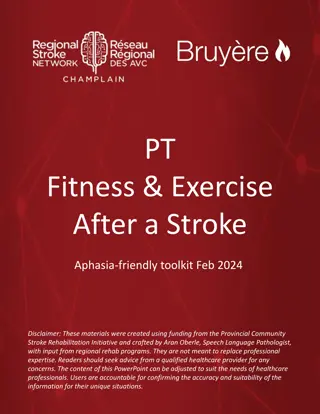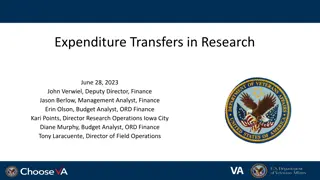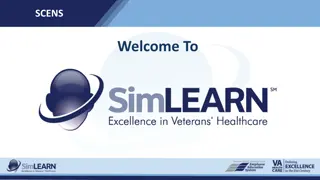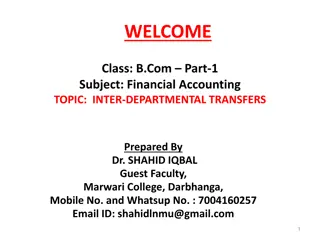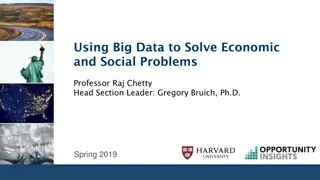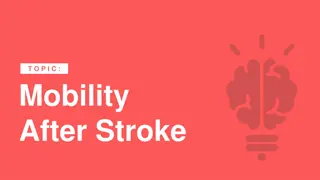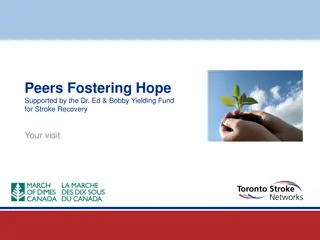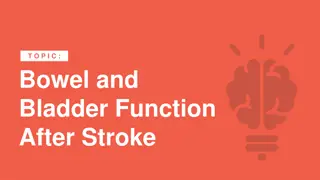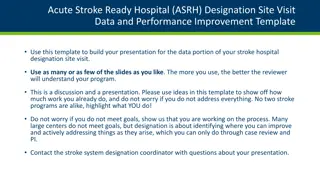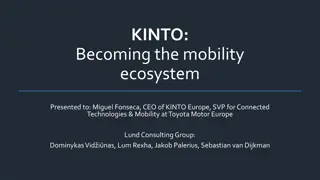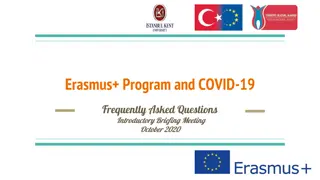Enhancing Mobility and Transfers After Stroke
Stroke can lead to various mobility challenges, including weakness and altered muscle tone. Proper handling and techniques are crucial for safe and comfortable movement. The article discusses bed mobility, transfers, and ambulation after a stroke, emphasizing the importance of protective practices and specific guidelines for assisting individuals in different movements.
Download Presentation

Please find below an Image/Link to download the presentation.
The content on the website is provided AS IS for your information and personal use only. It may not be sold, licensed, or shared on other websites without obtaining consent from the author.If you encounter any issues during the download, it is possible that the publisher has removed the file from their server.
You are allowed to download the files provided on this website for personal or commercial use, subject to the condition that they are used lawfully. All files are the property of their respective owners.
The content on the website is provided AS IS for your information and personal use only. It may not be sold, licensed, or shared on other websites without obtaining consent from the author.
E N D
Presentation Transcript
T O P I C : Bed Mobility, Transfers and Ambulation After Stroke
Bed Mobility, Transfers and Ambulation After Stroke A stroke can cause weakness, altered muscle tone, loss of coordination, changes in sensation and decreased body awareness Careful handling of the person during movement can improve safety and comfort 2
Bed Mobility, Transfers and Ambulation After Stroke What you should know: The safety and success of any mobility activity depends on a number of factors There are four main types of movement which include: Transitional Movements Transfers Ambulation Bed Mobility Always protect and never pull on the affected arm when moving 3
Bed Mobility, Transfers and Ambulation After Stroke Smart Tips: Before rolling, ask/ help the person to: 1. Bend their knees and place feet flat on the bed 2. Initiate the roll by allowing the knees to fall, turning the head, and reaching with the arm towards the direction of the roll, bringing their arm with the rest of the body Assist the person by helping at the back of theshoulder blade and hip as needed; never pull on the affected arm 4
Bed Mobility, Transfers and Ambulation After Stroke Once on their side, ask/ help the person to: 1. Bring their feet over the edge of the bed by moving their knees up towards their chest 2. Push up with the bottom arm to sit up. If assistance is needed, place one hand underneath the bottom ribs near the shoulder blade, and one hand on the upper hip Once sitting safely, lower the heightof bed if possible, to allow feet to be in contact with the floor 5
Bed Mobility, Transfers and Ambulation After Stroke Sit to Stand Stand on the persons affected side Ask/help the person to: 1. Shift hips towards front edge of the sitting surface 2. Place feet shoulder width apart, with heels under the knees 3. Sit up tall and bend forward at the hips while looking ahead 4. Push up from the bed with both hands, if able- do not pull on walker 5. Push through both legs with weight equally distributed 6
Bed Mobility, Transfers and Ambulation After Stroke Stand to Sit Stand on the persons affected side Ask/help the person to: 1. Before sitting, ensure the back of their legs are touching the sitting surface 2. Reach back to place their hand(s) on armrests or the sitting surface 3. Bend hips then knees to lower themselves slowly 4. Shift their hips back on the sitting surface 7
Bed Mobility, Transfers and Ambulation After Stroke Have the person move towards their stronger side Position the chair/ commode close to the bed Ensure brakes are applied and arm/foot rests are removed Ask the person to shift their hips forward to the edge of the sitting surface 8
Bed Mobility, Transfers and Ambulation After Stroke Position yourself close to the person, on their weaker side Guide the person onto their feet and help them shift their hips from one surface to the other Cue the person to reach towards the surface they are transferring to 9
Bed Mobility, Transfers and Ambulation After Stroke Walking Once standing, pause to ensure balance before walking. If a gait aid is used, have it nearby While walking, stand on the affected side and stay close to steady the person as needed Encourage the person to look ahead, not at the floor 10
Bed Mobility, Transfers and Ambulation After Stroke Seek extra support Physiotherapists and Occupational Therapists are skilled in mobility and transfers. It may be helpful to involve them if there are questions or concerns Notify the team if you notice a change in the person s ability to transfer or ambulate Smart Tips for Stroke Care (2023) was created by members of the Regional Stroke Networks of Ontario. This material may be shared without permission from the authors, without changes and with source credited. 11




